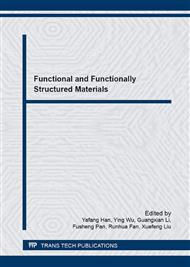p.18
p.23
p.28
p.32
p.38
p.43
p.49
p.57
p.64
Study on TaC Reinforced Iron Matrix Surface Gradient Composites Produced In Situ
Abstract:
Tantalum carbide (TaC) gradient composites were fabricated via in-situ fabrication method from the tantalum plate and gray cast iron. The morphology, phase constituents, micro-hardness, and relative abrasion resistance of the composites were analyzed by scanning electron microscopy (SEM), X-ray diffraction (XRD), micro-hardness tester and abrasive wear testing machine. The surface layer, which was ~160μm thick, was dense ceramic layer composed by ~90% submicron TaC particulates. The highest micro-hardness value of the dense ceramic layer was 13.84 GPa. In the sub-layer, the gradient distribution of TaC particulates reflected in the volume fraction decreased from 90% to 0%. While the micro-hardness value decreased from 10.81 GPa to 4.10 GPa. The metallurgical combination of the interface between the composites and matrix was perfect. The wear resistance of TaC reinforced iron matrix surface gradient composites increased significantly.
Info:
Periodical:
Pages:
38-42
Citation:
Online since:
March 2016
Authors:
Keywords:
Price:
Сopyright:
© 2016 Trans Tech Publications Ltd. All Rights Reserved
Share:
Citation:


